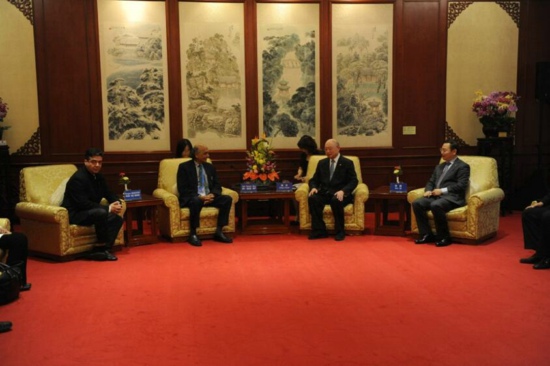The US mid-term election is a “mid-term exam” for the Trump administration. In the context of accelerated political polarization and social division in the U.S., the contest between the two major parties has tended to be more fierce, and the intensity of “political violence” during the election, the huge election expenses and the high level of voter mobilization have never been seen over the past decades. After the election, the Republicans have remained in control of the Senate, while the Democrats have regained control of the House of Representatives, thus bringing new changes to the US political ecology. The election results indicate that the “identity politics” championed by the Democrats has achieved some success, while the “Trumpization” within the Republicans is continuing, with the liberal and conservative forces in the U.S. locked in an intensified seesaw battle.
I. The Characteristics of the US Mid-Term Election
The mid-term election results, particularly the results of Congress election, have a national significance. But as a matter of fact, it is determined by the results of local elections. Factors such as political atmosphere on a national scale and party identification have great influence over the elections, while the election funds raised by individual candidates, their quality and the participation of the third party are also factors that exert important influence over the election results, which have added more uncertainties to the election. The US mid-term election this year was held amid political uproar and social agitation, with the results reflecting major changes in the US political and social ecology.
First, the tactic of “identity politics” adopted by the Democrats has achieved some success. Women, ethnic minorities and the homosexual groups are usually in favor of the Democratic Party politically, who constitute the basic voter base for the Democrats. Manifesting the gender and ethnic background of the candidates as well as making importance to the issues concerned by these groups in the election can send specific political signals and mobilize the voting enthusiasm to the greatest extent possible. In this mid-term election, the female candidates were very eye-catching for their firm stance on women’s rights, winning the name of “women’s year” for this year’s mid-term election since 1992. In the primary stage, the registration of female candidates running for governors, senators and congresswoman has set a new historical record, while the number of female candidates winning the pre-elections has also reached a record height. As the election results indicate, more than 100 females will get into the House of Representatives, setting a new record, and with the majority of them coming from the Democrats. The rising enthusiasm for political participation of women is closely related to the anti-Trump demonstrations and the “#MeToo” movement that opposes sexual harassment at workplace launched by women. Trump’s conservative policy on women’s right of abortion, his disrespect for women during his election campaign and administration, and the election defeat of Hillary Clinton as the first female candidate for presidency in American history are all factors that have raised the enthusiasm of women’s political participation. In addition, the Democratic candidates with both female and ethnic background have done well in the election, presenting a sharp tool for the Democrats to promote “gender politics” and oppose the “old white men” of the Republicans. Through “identity politics”, the Democrats have conducted a voter mobilization against Trump in this mid-term election, setting off a “blue tide”.
Second, the left-wing populism remains a major political force within the Democrats. Since the financial crisis in 2008, the call within the Democratic Party for universal medical care, free high education, narrowing the rich-poor gap, tax increase on the rich and gradually rendering citizenship to the illegal immigrants has been on the rise. They also advocated the adoption of the spirits of the New Deal to make a “progressive transformation” of the United States. During the national election of 2016, Senator Bernard “Bernie” Sanders, who called himself a “democratic socialist” representing the left-wing within the Democrats, showed a great deal of political energy, posing a serious challenge to Hillary Clinton from the Establishment Camp of the Democratic Party. During this mid-term election, Alexandria Ocasio-Cortez, a 29-year-old “political amateur” and follower of Sanders, accidentally defeated Joseph Crowley, an incumbent congressman and Chairman of the Democratic caucus, and won the nomination of the party in the Democratic primary of the New York State 14th Congressional District. Cortez’s nomination, with funds and high-level support within the party far less than those of her rivals, has rendered a great shock to the Democratic Party. In the end, Cortez also defeated her Republican opponent to become the youngest congresswoman in American history. In addition to the support gained from the young people in the same electoral district, Cortez also won supports from the Democratic Socialists of America (DSA), the biggest socialist group in the United States. The group has grown quickly for the participation of young people discontent with Trump, with its membership, whose average age is only 33, growing from thirty-two thousand in 2017 to fifty thousand by September of 2018.
Third, the “Trumpization” of the Republican Party is continuing. If the left-wing populism is said to be the undercurrent in American politics, the right-wing populism represented by Trump remains the main political stream in the United States. Trump’s personal characters and his policies have given rise to a great controversy, which is a “reminder weapon” for both parties. The American media has commented that “although Trump is not on the ballot, he has instigated the enthusiasm of both supporters and opponents”. According to the latest poll conducted by the Associated Press before the voting, two thirds of the voters took Trump as an important factor for their choices when casting their ballots.
Promoted by the election politics, the “Trumpization” of the Republican Party has continued to ferment rather than weakening. The “Trump Movement” created by Trump’s election campaign and the enthusiasm incited by it among his supporters have hedged against the clamors made by the Democratic Party, American media and some Republicans against Trump. The splendid performance of American economy, the great impacts exerted by the electioneering campaigns on local media, and the tough stance of Trump on the immigration issue have all effectively mobilized the basic voters of the Republican Party. So to speak, Trump has not only reshaped the leading ideas of the Republican basic voters, but also promoted the emergence of political figures within the Republican Party, who support his ideas and imitate his style. To maintain the control of the Senate, Trump had recognized 22 Senate candidates during his electioneering campaign for the Republican Party, most of whom won their elections. In Indiana, North Dakota and Missouri, where the Republican candidates defeated the incumbent Democratic senators, the “Trump Effect” was especially obvious. During this mid-term election, Trump had successfully promoted a huge number of Republican voters living in rural areas to vote, which was an important factor in turning these states “from blue to red”. From this perspective, it can be said that the “red tide” set off by the Republicans from 2010 to 2014 is not receding, with Trump remaining the primary political force that influences the Republican Party.
Fourth, some suburban residents have turned from the Republicans to the Democrats, enabling the Democratic Party to expand its influence to suburban areas. In American political geography, in additions to the traditional red states and blue states, the most conspicuous is the fact that the Democrats enjoy a high support rate in the cities, while the Republicans dominate the rural areas, with the city centers called the “blue districts”, the rural areas called the “red districts” and the suburban areas called the “purple districts”. The suburban residents are mostly wealthy and highly educated people, who are usually political swingers, swinging between the Democrats and the Republicans as affected by the election. In some congressional districts where the contest is fierce, there are about 36 million wealthy and well educated people living there, of whom at least 30 percent have university degrees with medium family income exceeding sixty thousand US dollars, and even reaching a hundred thousand US dollars in some districts. In this mid-term election, this group was more in support of the Democratic candidates. In Denver, Kansas City, Minneapolis and its surrounding areas where the red and blue forces confront, the Democrats won their victories, and in Houston, Dallas, Oklahoma City and Richmond, which used to be dominated by the Republicans, the Democrats also claimed some victories. These victories played a very important role in enabling the Democrats to get back its control over the House of Representatives, while turning more “purple districts” into “blue districts”. The American media has believed that the suburban residents, especially those female voters with higher education, are discontented with the extreme comments of Trump on all issues, which is the important factor that has promoted the transition.
II. The Influence on American Politics and Society
In the new Congress emerged from the mid-term election, the Democratic Party has become the majority party in the House of Representatives, which has resulted in not only the “split of the Congress”, but the “split between the government and the Congress”. Given the acuteness of the political contest and complexity of the social contradictions in the United States, this split may aggravate the political struggle in the U.S. and make it hard for the social rift to heal.
First, the power of President Trump will be further impeded. Trump has been in office for more than 20 months, during which the demand within the Democratic Party to impeach him has never stopped. Prior to the mid-term election, the Democratic billionaire Tom Steyer had initiated the “need to impeach” project and got 6 million supporters to sign their names, while some congressmen had tried to start the motion of impeachment. However, under the circumstance that the Republican Party was in control of both Houses, the Democratic leaders refused to support the motion of impeachment, as both the minority leader in the House of Representatives Pelosi and the former Vice President Biden believed impeachment without sound proofs would not do any good to the Democratic Party. More importantly, as the Republicans remain in control of the Senate, they are likely to block the Democrats to set the impeachment in motion. So, the success of an impeachment is not likely. Although the Democratic Party is not to impeach Trump, it will increase its momentum of supervision on him. As soon as the Democrats won back the control of the House of Representatives, Pelosi expressed the party would “give a full play to the Congress to balance the president”. In future, the elected Democratic congressperson will take the positions as the Speaker of the House of Representatives, the Chairman of the Judicial Committee, the Chairman of the Intelligence Committee, and the Chairman of the Government Oversight and Reform Commission, who are likely to dig into the misconducts of Trump during his election campaign and before coming to office, and investigate into the suspicion that Trump “tampered with the judiciary process” in the case of firing the former FBI Director James Comey, to launch a political attack on Trump. In fact, the Democratic Party and some Republican congressmen have certain consensus, as they all feel it necessary to restrict the president’s power with regard to some practices of Trump in exercising his power, such as pardoning the former Sheriff Joe Arpaio of Arizona, cancelling the security clearance of former CIA Director John Brennan, and demanding Robert Muller disclose the confidential information involving his investigation into Russian interference in the US election.
Second, President Trump’s administrative agenda will get more disturbed. In 2018, the two parties have had certain cooperation on major legislation to keep uncontrolled political contests from leading to a congressional deadlock and loss-loss ending. The two parties promoted the National Defense Authorization Act for FY2019 to get passed in both houses with high votes in September, which is the first National Defense Authorization Act to get passed not as a Continuing Resolution Act in nearly 40 years, thus reflecting a rather high efficiency in legislation. In early 2018, the two parties contested fiercely over the appropriation for the separation wall at the US-Mexico border and the DACA, which resulted in a temporary close-down of the government. To avoid repeating such a farce, which may cause losses of voters, the two parties joined hands in September to promote some government budget acts, which has enabled the government to operate till December 7 this year. The Speaker of the House of Representatives Paul Ryan said, this was the first time for the US Congress to place the government budgets in time before the president since 2007.
In the wake of the mid-term election, in consideration of the 2020 national election, the Democratic Party is sure to create more obstacles to President Trump and the Republicans, the easiest of which is to best obstruct rival’s administrative agendas at the level of the House of Representatives. Trump has expressed that after a successful and substantial tax cuts for enterprises and individuals, he would concentrate on tax cut for the middle class, remain committed to promoting the construction of the separation wall at the US-Mexico border, and continue with his “zero tolerance” policy on illegal immigrants. In all of these, the Democratic Party is sure to place obstacles in the way. In addition, the two parties will be locked in fierce contest over such issues as the future of the DACA and adjustment of the “family immigrants” and “green card drawing” systems. The legislative obstruction placed by the Democratic Party is also likely to concentrate on budget areas, so new crisis of government close-down cannot be excluded.
Last, the division of the American society will be more serious. Since the financial crisis in 2008, the U.S. has entered a new period of high incidence of social movements. The “Tea Party” movement, the “Occupy Wall Street” movement, and the “Black Lives Matter” movement that opposes the police abuse of violence against the Afro-Americans occurred one after another. Since the national election of 2016, the “#Me Too” movement has grown up, while the “Black Lives Matter” movement has been translated from fierce and large scale mass protests into a network movement, echoing the “Our Lives Are Important As Well” movement that demands gun control and opposes gun violence, which influence the direction of policy debate of the US government over guns and law enforcement. That Trump has increased the momentum of detention and repatriation of illegal migrants, with his controversial “family separation” policy in particular has aroused the left-wing groups to stage a counter strike. Meanwhile, the right-wing social movements and social thoughts have been fermenting, and hatred crimes committed by such White supremacy group as the “United Right-Wing” and the xenophobia groups are also in a period of high incidence. With the US economy continuously improving, the class contradiction in the U.S. seems to be relaxing, but the countercharge effect produced by political contest on society has been increasing. The “identity politics” emphasized by the Democratic Party and the instigation made by Trump on the Republican basic voters have made different groups in the U.S. more willing associate with the people of the “same kind”, thus decreasing the social inclusiveness and openness. A situation of more fierce political contests is anticipated in the future, which is difficult to reverse, continuing to deepen the social division in the U.S. and speed up the erosion of social capital that emphasizes mutual assistance and solidarity.
The author is Associate Research Fellow and Director from the Division for American Political Studies of the Institute for American Studies, CICIR. This article was received on Nov. 25, 2018.




